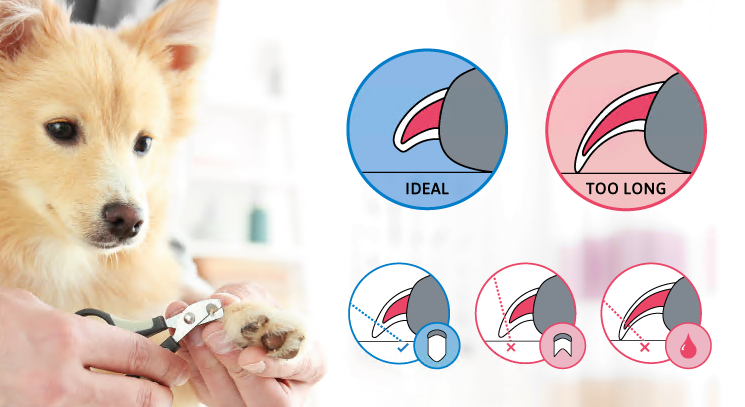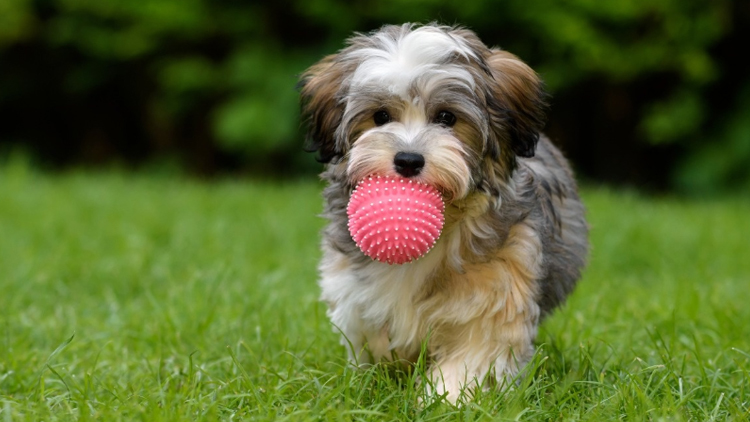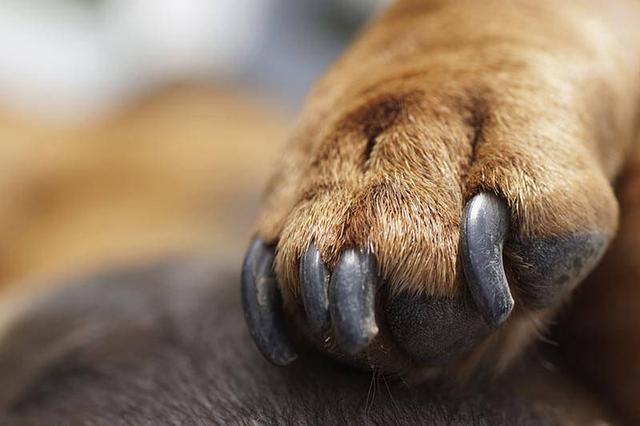Regularly cutting or filing your dog’s nails should be a routine part of dog grooming. Trimming the nails is an obvious sign of your dog’s health and hygiene. Trimming the dog’s nails can prevent them from suffering unnecessary pain.
Trimming your dog’s nails is an anxiety-causing task for you and your dog. So when the puppies are young, start to touch their feet and trim their nails so that they will get used to this process. Some dogs will sit on your lap or on the table while you are cutting your nails, while other dogs may require some form of restraint.
Tip: You can let your dog lick off the peanut butter from the spoon while processing the nails, thus making this process more interesting for your dog.


Dog nail anatomy
Your dog’s toenails consist of two main parts. There is the nail itself, which is a hard shell, similar to the growth of human nails. Then there is the quick inner epidermis of blood vessels and nerves. The nail itself has no nerve endings, so when you trim it, your dog won’t feel anything. However, accidentally trimming quick can cause pain in the dog.
When trimming your dog’s black nails, learning to avoid quick will save you both a lot of stress.


How short should you cut your dog’s nails?
It is important not to be caught behind the natural curve of the nail, because this is where the “quick” starts.
Almost the central part of the nail, containing blood vessels and nerves. If you accidentally cut this part of your nail, it will cause your dog to bleed and some pain.
If you are worried that your nails may be too close to the quick cut, it is best to keep your nails longer.
If you feel uncomfortable with this process at any time, or think you are causing your dog’s pain, please stop and contact your local veterinarian for further instructions.


Tools for trimming your dog’s nails at home
The right tools can make trimming your canine partner’s nails a breeze. The classic ‘guillotine’ nail trimmers are the fastest, although they are also the type that can cause accidental bleeding. If you want to make your dog’s nails yourself but don’t like to use scissors, or if they have been trimmed recently but just need to be touched up, you can consider using a grinder and just gradually grind away the nails instead of cutting them off-this way It is easier to avoid any accidents. Which one to use depends on you.
Put some snacks nearby for positive reinforcement to help your dog not be so afraid of trimming nails.
No matter which type of trimmer you use, be sure to prepare a styptic powder. Styptic powders can quickly constrict blood vessels to slow bleeding. They are also suitable for small scratches and abrasions, so it is a good idea to put one in your puppy’s first aid kit.
Be sure to cut nails correctly
“If you’ve never cut a dog’s nails before, it’s best to have your veterinarian teach you how to do it.” suggested Dr. Jerry Klein, Chief Veterinary Officer of AKC.
Before you try to cut your dog’s nails, it may be helpful to get your dog to get used to the sight and sound of nail clippers.
Try to take out the nail clippers, click on them, and let your dog smell them on different occasions (instead of actually cutting nails) so they will get used to them.
When the scissors come out, give your dog something delicious.


The following is a safe way to cut dog nails:
Find a quiet area where your dog is comfortable and undisturbed.
If you have a puppy, hold your dog on your lap or place them on a stable surface. If you have a large dog, it can be helpful to have another person hold your dog while you are cutting your nails.
Use your thumb and index finger to gently but firmly hold one of the dog’s paws.
Gently push down on the paw pad to extend the nail forward. Make sure that no hair is blocking your view of the entire nail.
When your dog stays still, clamp it directly on the tip of the nail. Don’t get caught behind the natural curve of your nails.
Give a lot of high-value hospitality before, during and after, linking nail trim with generous rewards.
How to grind your dog’s nails
Use safe tools to sharpen your dog’s nails.
Only a small part of the dog’s nails are polished at a time. Support the dog’s toes firmly but gently.
Sand the bottom of the nail, and then carefully sand from the tip of the nail to smooth out the rough edges.
For better control, please lift the grinder upwards, towards the top.
Keep your dog comfortable and watch out for any sensitivities
If your dog has long hair, make sure to keep it away from grinding tools to avoid being pinched.
Make your dog comfortable
In just one week, you can have a rare dog that doesn’t mind trimming your nails. However, if your puppy takes longer to adjust to it, don’t despair. Be patient, maintain a gentle and positive attitude, and continue to provide compliments and hospitality. Make sure to use safe, dog-friendly scissors or grinders.


Tip: It helps if you frequently touch and hold your puppy’s paws (lightly and happily) from day one, so that they will not become sensitive to the feet being stroked.
Day 1: Let your puppy smell the nail clippers or grinder. Give hospitality and praise.
Day 2: Lightly touch each paw with nail clippers or a grinder. Give hospitality and praise.
Day 3: Touch the nail clippers to each paw and squeeze the nail clippers to let the puppy hear the sound, or turn on the grinder to let the puppy feel the vibration. Don’t actually trim your nails. Give hospitality and praise.
Day 4: Touch the nail clippers or grinder to the puppy’s feet again. Give hospitality and praise.
Day 5: Try to trim only the smallest tip on the nail of one front claw. Just make a nail. If your puppy allows, please give lots of happy compliments and hospitality. Even if he asks you, he will only be one. Repeat every day until he asks you to do this and doesn’t seem to mind.
Day 6: Try to trim only the tips of two nails.
Day 7: Keep working hard and trim additional nails every day until you have cut all nails and your puppy doesn’t mind. You can practice even without cutting your nails. Even pretending that you are cutting your hair and completing the action can help your puppy adapt to the whole process.
How often should you trim your dog’s nails?
The length of time between nail trimming depends on how fast your dog’s nails grow and wear.
Normal dogs should trim their nails every three to four weeks, but they should be trimmed as often as necessary to prevent the nails from touching the ground when your dog is standing.
If your dog is a pug whose feet rarely touch the ground, you may need to trim their nails more frequently, while dogs running on sidewalks or rough surfaces may not need to trim their nails often or at all.


What to do if you cut the quick
If you trim your nails too deep by mistake and cause them to bleed, a little styptic powder can solve the problem. Styptic powder can be used to help stop nail bleeding by helping blood to clot. If you don’t have a styptic powder, you can also use flour or cornstarch to stop your dog’s nails from bleeding, and you can use it like a styptic powder.
Pour a small amount on the fingertips, and then press the powder into the nail tips.
Pressure can be applied for a few seconds to allow the hemostatic powder to adhere.
If the bleeding does not stop after a few minutes, call your veterinarian for further advice.

